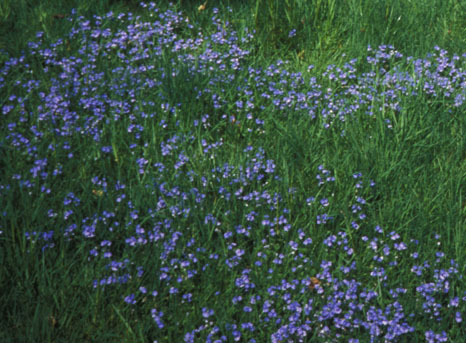
|
| Lawn Veronica; Veronica filiformis Sm. |
Plantain Family; PLANTAGINACEÆ
|
formerly Figwort Family; SCROPHULARIACEÆ
|
| Lawn Veronica or Speedwell is a perennial or sometimes annual herb of relaxed aspect, trivial size and endearing charm. Native
in and near the Caucasus region of Asia Minor, its beauty inspired gardeners to plant it as a groundcover in rockeries and such places.
But, despite its dainty appearance and small size, it proved no tender weakling. On the contrary, it has been found definitely weedy. |
| In moist lawns it spreads vegetatively and by reseeding. A piece of its stem or a few of its seeds stuck on the blade of a mower
can be taken from one lawn to another. We see how abundant it is when it brightens lawns with its pale blue flowers from mid-March
through May or early June. Go ahead, try to trample it underfoot, weed it, poison it. You'll find
Veronica virtually impossible to abolish. |
| Book names, all of them apt, are Lawn Speedwell, Threadstalk Speedwell, Slender Speedwell, Creeping Speedwell and
Round-leaved Speedwell. Leaves are about a third of an inch long, and each bears an elegantly long-stalked flower of a third to a half an inch long.
Of ten additional species of Veronica known to grow wild in Seattle, only two are also common lawn weeds: Germander Speedwell
(Veronica Chamædrys L.), an immensely attractive European species with bigger, darker flowers and leaves; and Thymeleaf Speedwell
(Veronica serpyllifolia L.), a European runt with small, pale flowers and small foliage almost rubbery in aspect. |
While no Veronica is found exclusively in lawns,
Veronica filiformis most consistently grows there. Some of its cousins
have interesting English names and old-fashioned domestic herbal lore; it has
none. Depending upon individual opinion, it is either a
pretty ornament gracing lawns or a hated weed disfiguring them.
|
Originally published as the Seattle Tilth newsletter Weed of the Month in May 1987, along with an illustration drawn by Jerri Geer.
Back |
|
|

